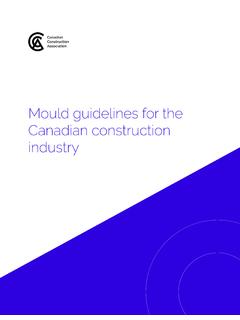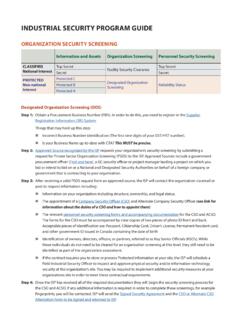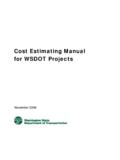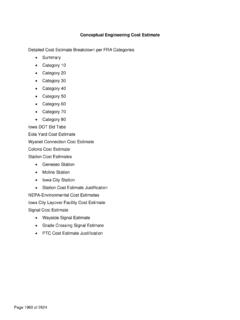Transcription of Guide to Cost PrediCtability in ConstruCtion
1 Guide to cost PrediCtability in ConstruCtion :an analysis of issues affeCtinG the aCCuraCy of ConstruCtion cost estimatesPrepared by the Joint Federal Government / Industry cost PrediCtability Taskforcenovember 2012 Guide to cost PrediCtability in ConstruCtion : An Analysis of Issues Affecting the Accuracy of ConstruCtion cost EstimatesNovember 2012 Table of ContentsNote from the Taskforce Chairman ..1 Executive Summary ..2 Taskforce Participation ..3 Introduction to the cost PrediCtability Issue ..4 Issues and Considerations in cost PrediCtability ..6 cost Estimate Variance Matrix ..9 Recommendations for Improved cost PrediCtability ..10 Postscript ..11 Appendix 1 Classes of estimates .
2 12 Appendix 2 Documents Recommended for estimates ..14 Appendix 3 Qualifications for Estimators and cost Consultants ..21 Appendix 4 Sources of Information and References ..24 Enquiries should be directed to: Canadian ConstruCtion Association Guide is the product of the individual taskforce members collective input and does not purport to express or represent the position of their respective organizations or associations. It reflects recommended industry practices. Readers are cautioned that this Guide does not deal with any specific fact situation or circumstance. This Guide does not constitute legal or other professional advice. The taskforce and their respective organizations or associations do not accept any responsibility or liability for loss or damage which may be suffered as a result of its use or 2012 Must not be copied in whole or in part without the written permission of the Joint Federal Government / Industry cost PrediCtability to cost PrediCtability in ConstruCtion .
3 An Analysis of Issues Affecting the Accuracy of ConstruCtion cost EstimatesNovember 20121 Note from the Taskforce ChairmanWhat at first appeared to be a relatively simple task to review the various and mostly obvious causes of poor cost PrediCtability increasingly grew in each taskforce meeting as more and more variables were raised and reviewed. As the topics for consideration ranged from first bid comparison, whether low, median or average, to cost growth during ConstruCtion , to final project cost , and even whether to review various soft costs to the extent that they may have an effect on cost PrediCtability , etc., it soon became apparent that a clear and rigid definition of the scope of the taskforce had to be established.
4 This would limit the discussions to achieve definable recommendations relating to the original rationale for the taskforce, which was to analyze the increasingly large variances being experienced by PWGSC, DCC, and others between their pre-tender estimate and the subsequent contractors bids. The basic question whether such increasing variances are the result of the ConstruCtion industry s pricing strategies , or of an inaccurate or insufficient estimating process, was soon concluded to be the latter, since with few exceptions, under a normal and competitive bidding process actual bid prices are generally the best indicator of the prevailing competitive market conditions for a specific project at that time.
5 Upon further review it was also found that the owners estimating process was seldom properly completed up to a reasonable Class A level, and in most cases only up to Class B, or even a brought forward Class C!Also, it must be recognized that each project is unique and different from the previous one in varying degrees. Although many projects may be relatively repetitive and similar , such as standard office buildings or schools, many others are non-standard and individually complex, unique, one-of-a-kind, remotely located, etc., or any combination thereof, such as leading edge lab facilities, historic building renovations, environmentally challenged locations and increasingly green, sustainable, and more innovative structures and , since the preparation of project estimates has typically been based on historical information, such information may be outdated, or perhaps not even exist for certain individual types of projects.
6 Therefore, the associated degree of accuracy of the estimate can be expected to vary this reason the taskforce concluded that the previously accepted degree of accuracy for Class A estimates should be expanded from +/- 5% to a range of +/- 5 to 10%, to accommodate the range of such non-standard projects, with a similar variation applied to the other classes of estimates . As well, for projects involving significant renovations, or challenging geographic, environmental, or other unique circumstances, a further allowance should be analyzed and addition, whereas the previous cost PrediCtability guidelines were related primarily to the degree of design development completion, it became obvious that with the increasing variety and complexity of various projects, the potential accuracy of estimates must equally recognize the relationship to the level of complexity of any particular project , or its level of estimating difficulty.
7 For this reason, a cost Estimate Variance Matrix was developed, to recognize the combination of both these dimensions in arriving at a reasonable estimate variance. Finally, since estimating and bidding is not an exact science, the expectation for estimate accuracy must be realistic, in relation to the particular type of project and in proportion to the quality and time expended to produce a specific level of estimate accuracy. But at any level, adherence to the recommendations of this Guide should definitely improve cost this respect it bears repeating the obvious, that to achieve a realistic Class A estimate requires the following ingredients:1. Class A professional and experienced estimating qualifications;2.
8 Class A completed project design documentation; and3. Class A time, sufficient to produce the required estimate analysis with , the taskforce was fortunate to have the benefit of senior, experienced, informed, articulate, and independent cross-sector representatives; I sincerely want to thank each of them for their effective and dedicated participation in the production of this to cost PrediCtability in ConstruCtion : An Analysis of Issues Affecting the Accuracy of ConstruCtion cost EstimatesNovember 20122 Executive SummaryLarge discrepancies between pre-tender estimates and actual bids for ConstruCtion have a serious impact on the viability of a project . Owners, architects, engineers, cost consultants, contractors and subcontractors all have a vested interest in ensuring a high degree of cost PrediCtability .
9 This issue, raised at the Federal Government / Industry Real Property Advisory Council, resulted in the formation of a cost PrediCtability Taskforce, to research and recommend solutions to this increasing cost PredictabilityFor the purpose of this Guide , cost PrediCtability is defined as the prediction of a ConstruCtion cost estimate, as compared to the median of competitive bids , where prediction is defined as an assertion on the basis of data, theory or experience, but in advance of proof .As such this Guide will apply only to procurement processes that typically require the submission of a total project bid, such as a design-bid-build or design-build process, and although not directly applicable to the ConstruCtion management process, it could also be applied to the sequential trade contractors bids.
10 Similarly, many of the same underlying principles could also be applied to the further development of cost PrediCtability guides for the increasing range of P3 and lease/purchase procurement process variations. Taskforce AnalysisThere is no common statistical database on variances between pre-tender estimates and final bid results for the Canadian ConstruCtion market. However, members of the task force shared internal data that showed up to 40% of tenders had low bids that varied, either up or down, by more than 30% from the pre-tender estimate and fewer than 20% of tenders had bids within 10% of the estimate. While this was not the case with all of the taskforce members, all agreed that cost PrediCtability was an increasingly serious issue facing the was agreed that the following key actions are required to ensure better cost PrediCtability : engage qualified professionals to prepare estimates ; use appropriate economic models in the estimating process; ensure that the project approval process recognizes cost PrediCtability issues; include scope revision mechanisms in the project approval process; and recognize the degree of accuracy of the estimate being large number of factors contribute to variances in estimate to bid prices.






